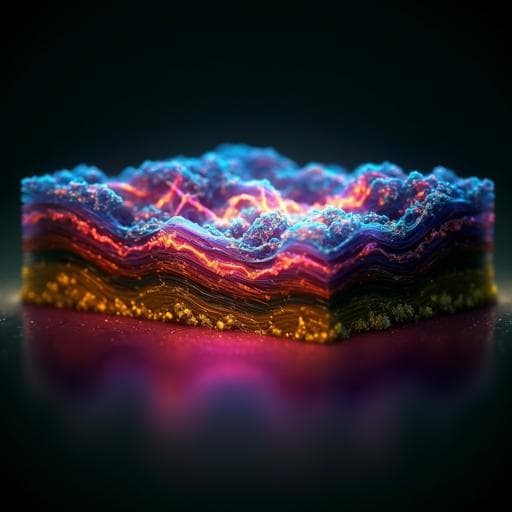
Physics
Atomic-scale visualization of a cascade of magnetic orders in the layered antiferromagnet GdTe₃
A. Raghavan, M. Romanelli, et al.
Discover the intriguing world of GdTe₃, a layered antiferromagnet explored by researchers Arjun Raghavan and colleagues. This study showcases the direct imaging of charge and magnetic orders, revealing a fascinating interplay between charge density waves and magnetic phases that occur below 12 K. Uncover the secrets behind its unique properties and the cascade of magnetic transitions!
~3 min • Beginner • English
Introduction
Layered antiferromagnets offer a fertile platform to study the interplay between magnetism and dimensionality with potential in spintronics and twistronics. Rare-earth tritellurides (RTe₃) host a unidirectional incommensurate CDW with wave vector q_CDW ≈ (0, ±1/5 b, 0) in space group Bmmm, tunable by rare-earth substitution. Most RTe₃ members are magnetic and order antiferromagnetically above 2 K. Earlier work attributed the CDW to Fermi surface nesting, whereas more recent studies indicate strongly momentum-dependent electron–phonon coupling as the driver. The quasi-2D structure separates itinerant Te-plane electrons (driving the CDW) from localized rare-earth moments (on RTe blocks), creating opportunities to explore charge–spin interplay and multiple magnetic ground states.
GdTe₃ has drawn significant attention for record-high mobility among van der Waals layered magnets, potential use in low-temperature spintronics, and superconductivity under pressure. Bulk measurements show a cascade of low-temperature transitions around ~12 K, ~10 K, and ~7 K, also seen in susceptibility, indicating multiple magnetic phases. However, the order parameters of these magnetic phases remained unknown, partly due to the large neutron absorption of Gd that complicates neutron scattering. The present study aims to directly determine the magnetic order parameters and their relation to the CDW using spin-polarized STM and to elucidate how charge–spin coupling can generate a cascade of magnetic orders.
Literature Review
- The RTe₃ family exhibits a unidirectional incommensurate CDW with q_CDW ≈ 0.2·(2π/b); initial nesting-based interpretations have been superseded by evidence for wave-vector dependent electron–phonon coupling.
- Most RTe₃ members (except LaTe₃, TmTe₃, and ErTe₃) order antiferromagnetically above 2 K; the magnetic moments reside on rare-earth sites while itinerant electrons on Te planes drive CDW formation.
- GdTe₃ shows highest mobility among layered magnets, superconducts under pressure, and has T_CDW ≈ 378 K. Prior bulk measurements reported multiple transitions (~12, ~10, ~7 K) but the corresponding magnetic structures were unresolved due to experimental challenges (e.g., Gd neutron absorption).
- Prior STM/ARPES and Raman works on RTe₃/GdTe₃ have characterized CDW periodicities, near-commensurability, gaps, and possible unconventionality; strain can reorient CDWs and induce coexistence of orthogonal CDWs in related compounds (TbTe₃, ErTe₃).
Methodology
- Materials and growth: GdTe₃ single crystals grown by self-flux (≈2 mm × 2 mm). Calibration crystals: Fe₁.₀₃Te.
- Sample preparation: In situ cleaves of Fe₁.₀₃Te and GdTe₃ at 77 K.
- STM setup: W and Cr tips used. W tips (250 µm) electrochemically etched in NaOH; Cr tips (300 µm) etched in H₂SO₄. Both annealed in vacuum prior to use. Cr tips provide spin-polarized sensitivity and were calibrated on antiferromagnetic Fe₁.₀₃Te.
- Measurements: Spin-averaged STM with W tips for structural/electronic imaging; spin-polarized STM (SP-STM) with Cr tips for magnetic contrast. Topographies and dI/dV spectroscopy acquired; lock-in detection at 913 Hz. Temperature control via Joule heating (Cu coil) and Lakeshore 340, exploring ≈4–14 K for magnetic transitions (T_CDW ≫ room temperature).
- Data analysis: 2D Fourier transforms (FTs) of topographies to identify Bragg, CDW, and magnetic peaks; quasiparticle interference bands analyzed. Fourier peak intensities extracted from 3×3-pixel averages at peak locations; background from distant 3×3 regions. Inverse FTs combining selected peaks used to real-space visualize orders. Occasional mirror symmetrization or nearest-neighbor FT averaging noted. Linecuts along crystallographic axes quantify periodicities and commensurability.
- Domain wall studies: Large-area scans across CDW twin/domain boundaries to examine rotation and coexistence of orders.
- Theoretical modeling: Minimal Ginzburg–Landau free energy including CDW order P_Q, c-axis AFM order S_q, and SDW S_{Q+q}, with a tri-linear coupling term to capture a daughter SDW induced by coexistence of CDW and c-axis AFM.
Key Findings
- Low-temperature magnetic ground state (<~7.5 K): A commensurate striped in-plane AFM with q_AFM = (±½ G_a, 0) i.e., peaks at exactly half the Gd Bragg wave vector along one in-plane axis (a), perpendicular to the CDW direction (b). Real-space inverse FT shows alternating spin stripes on the Gd lattice. The AFM peak intensity vanishes by ~7.9 K and reappears upon cooling; Néel temperature for this striped AFM ≈ 7.5 K.
- Intermediate-temperature magnetic order (≈7–12 K): A spin density wave (SDW) with the same in-plane wave vector as the CDW, detected as a pronounced increase of the CDW FT peak intensity only with a spin-polarized (Cr) tip. W-tip measurements show no systematic temperature dependence of CDW peak intensity, and dI/dV spectra at 4.4, 9.9, 13.9 K are nearly identical, ruling out an electronic DOS origin. The SDW onsets near 12 K, peaks around ~10 K, and disappears between 7–8 K.
- Charge–spin coupling mechanism: A Ginzburg–Landau free energy with a tri-linear coupling between CDW (P_Q), c-axis AFM (S_q), and SDW (S_{Q+q}) explains the SDW as a daughter order arising when c-axis AFM develops near 12 K in the presence of an existing CDW (T_CDW = 378 K). Because q (c-axis AFM) is normal to the surface, the SDW and CDW share the same in-plane wave vector on the surface.
- Orientation relationship: AFM stripes are always transverse to the CDW. Across 90° CDW twin boundaries, the AFM peaks rotate by 90° in lockstep with the CDW.
- Domain walls: Near CDW domain walls, bidirectional CDWs coexist, accompanied by bidirectional AFM peaks. AFM persists despite expected Fermi surface gapping in both directions, suggesting the Fermi surface may not be critical to establishing the AFM.
- CDW characteristics: q_CDW ≈ 0.288 of the Bragg wave vector, close to a commensurate value 0.286 (17/59). dI/dV spectroscopy shows slope changes at −210 meV and +210 meV consistent with CDW gap edges. Quasiparticle interference is strongest perpendicular to the CDW direction.
- Phase sequence: Upon cooling: paramagnetic → c-axis AFM + CDW → daughter SDW (q_SDW ≈ q_CDW) between ~12 and ~7.5 K → striped in-plane AFM (q_AFM ⟂ q_CDW) below ~7.5 K.
Discussion
The study directly determines the magnetic order parameters underlying the cascade of low-temperature transitions in GdTe₃, addressing a long-standing question unresolved by bulk probes due to Gd’s neutron absorption. SP-STM reveals that below ~7.5 K the ground state is an in-plane commensurate striped AFM with periodicity twice the Gd lattice along one in-plane axis and oriented perpendicular to the unidirectional CDW. Between ~7 and 12 K, a hidden SDW with the same in-plane wave vector as the CDW emerges; its presence is inferred from a spin-sensitive enhancement of the CDW FT peak using a spin-polarized tip, while spin-averaged measurements and local DOS remain unchanged.
A minimal Ginzburg–Landau framework with a tri-linear coupling between the pre-existing high-T CDW and a c-axis AFM order explains the SDW as a daughter order S_{Q+q}, naturally sharing the in-plane wave vector of the CDW without fine tuning. This mechanism highlights how charge order can imprint spin modulations when another magnetic order develops, generating a cascade of magnetic textures upon cooling. The persistence and reorientation of AFM relative to CDW, and the coexistence of bidirectional CDW/AFM at domain walls, further underscore robust charge–spin coupling and suggest that detailed Fermi surface nesting is not essential for the striped AFM formation. These results are significant for understanding intertwined orders in layered magnets and for leveraging antiferromagnets in spintronic devices where control of competing orders is crucial.
Conclusion
This work uses spin-polarized STM to uncover the in-plane magnetic orders of GdTe₃: (1) a low-temperature commensurate striped AFM with q_AFM ⟂ q_CDW below ~7.5 K, and (2) an intermediate-temperature SDW with q_SDW ≈ q_CDW between ~7 and 12 K, interpreted as a daughter order resulting from coupling between a c-axis AFM and the pre-existing CDW. A Ginzburg–Landau model captures how the tri-linear coupling produces the SDW without fine tuning. The methodology—comparing temperature evolution of FT intensities with spin-polarized versus spin-averaged tips—provides a general route to detect hidden spin orders sharing periodicities with other orders. Future work could include SP-STM under in-plane magnetic fields and systematic studies across the RTe₃ series to map how strain, dimensionality, and rare-earth choice tune the hierarchy and coupling of charge and spin orders.
Limitations
- SP-STM is surface-sensitive and measures the in-plane projection of 3D spin structures; direct detection of c-axis AFM in the bulk is inferred rather than imaged.
- The minimal Ginzburg–Landau model focuses on the 12 K transition and does not fully capture the low-temperature transition at ~7.5 K; additional symmetry-allowed terms and interlayer couplings may refine the description.
- The exact nature of the transition between the intermediate c-axis AFM/SDW regime and the low-T striped AFM (continuous with rotation, reentrant via a narrow paramagnetic window, or first-order) remains unresolved.
- Neutron scattering is hindered by Gd absorption, limiting complementary bulk confirmation of magnetic structures; alternative bulk probes could strengthen conclusions.
- Multiple domains and local strain near domain walls complicate disentanglement of intrinsic versus strain-induced bidirectional order; quantitative strain mapping was not performed.
Related Publications
Explore these studies to deepen your understanding of the subject.







